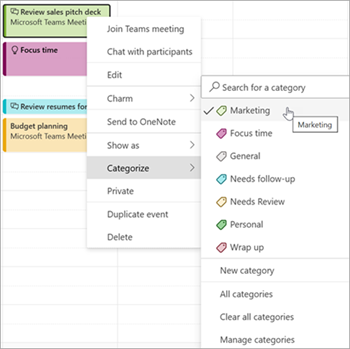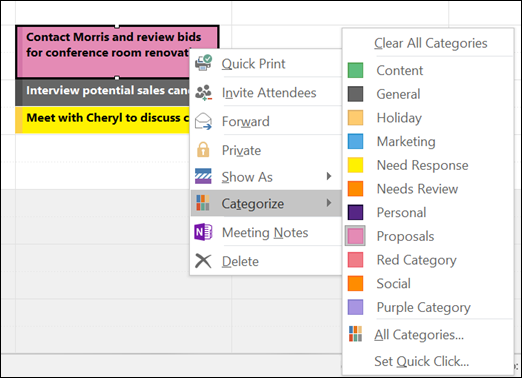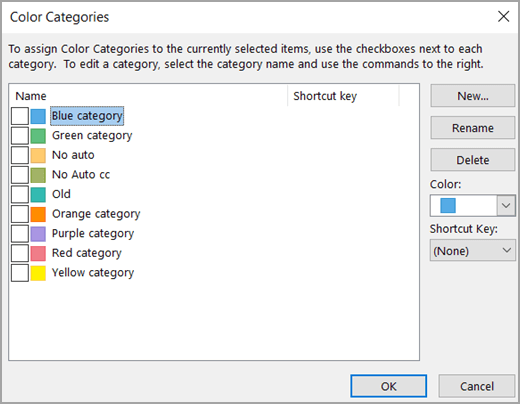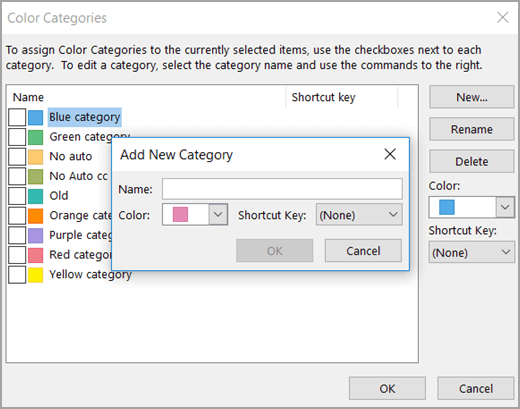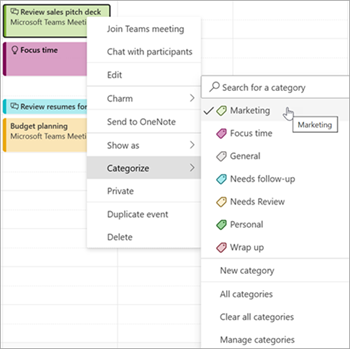Assign a color category to a calendar event in Outlook
Applies To
Color categories in Outlook help you more easily recognize and organize related items. You can apply them to meetings, appointments, emails, notes, contacts, and more.
Once assigned, the color category indication appears within the individual item and also in collective table views (e.g., Inbox). If needed, you can assign multiple color categories to a single item. You can also customize the names and colors of your available color category set.
Note: If you apply a color category to a meeting or request that you've received from another person, the color category selection will not affect their Outlook view. Your category selections apply only to items within your calendar.
Select a tab option below for the version of Outlook you're using. What version of Outlook do I have?
Note: If the steps under this new Outlook tab don't work, you may not be using new Outlook for Windows yet. Select the Classic Outlook tab and follow those steps instead.
Add a category to a calendar event in new Outlook
-
Select Calendar
-
On your calendar, right-click a calendar event and select Categorize. Or open the calendar item and from the ribbon under the Event tab, select Categorize.
-
Select a category from the list. If you want to assign a second or third color category, you can perform this action multiple times. Categorize displays the most recently used categories. If you have additional categories, select Manage categories to see the rest of your list. The same listed categories are available for use on all Outlook item types, such as contacts and messages. If you don't find the category color that you want in the initially displayed list, select All Categories. There you'll see other category options and be able to create and assign new categories. See Create and assign color categories in Outlook.
Manage categories in new Outlook
-
To change the color of categories or create new ones, select the File tab and Account info, or Settings, then Accounts > Categories.
-
For any displayed category name, select the appropriate icon for any of these actions:
-
Select
-
Select
-
Select
Assigning color categories in classic Outlook
To assign a color category to an appointment, meeting, or event in classic Outlook, use one of the following options:
-
From your main calendar view, right-click the appointment, meeting, or event. Then point to Categorize
-
Within an open appointment, meeting, or event in classic Outlook, locate the Categorize button
The Color Categories dialog box in classic Outlook
To see more categories or to create a new category, select All Categories in the drop-down list. This will open the Color Categories dialog box. To assign a color category select the associate check box. You can also assign multiple categories to a single item.
The first time that you assign a default color category to an item in classic Outlook, you will be prompted to rename the category. At this time, you can also change the color of the category and assign a keyboard shortcut.
Notes:
-
At any time, you can change the color associated with a category name.
-
You can click Categorize
-
Only the fifteen most recently used color categories appear on the Categorize menu. To see the others, go to the Categorize menu and select All Categories.
Add a category to a calendar event in Outlook on the web
-
Select Calendar
-
On your calendar, right-click a calendar event and select Categorize. Or open the calendar item and from the ribbon under the Event tab, select Categorize.
-
Select a category from the list. If you want to assign a second or third color category, you can perform this action multiple times. Categorize displays the most recently used categories. If you have additional categories, select Manage categories to see the rest of your list. The same listed categories are available for use on all Outlook item types, such as contacts and messages. If you don't find the category color that you want in the initially displayed list, select All Categories. There you'll see other category options and be able to create and assign new categories. See Create and assign color categories in Outlook.
Manage categories in Outlook on the web
-
To change the color of categories or create new ones, select the File tab and Account info, or Settings, then Accounts > Categories.
-
For any displayed category name, select the appropriate icon for any of these actions:
-
Select
-
Select
-
Select


